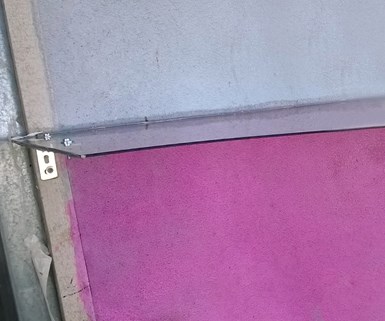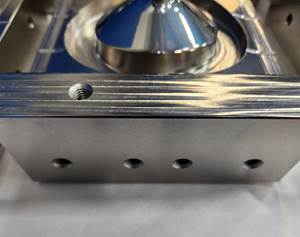Smog-Eating Graphene Composite Coating Reduces Atmospheric Pollution
Study found that when titania is exposed to sunlight, it degrades nitrogen oxides which are harmful to human health.
Researchers have developed a graphene-titania photocatalyst that degrades up to 70% more atmospheric nitrogen oxides (NOx) than standard titania nanoparticles in tests on real pollutants.

Photocatalytic panel exposed outdoors. The purple section is treated with a pollutant, rhodamine B. A small plexiglass roof protects the treatment from being washed away by the rain.
The study was done by the Graphene Flagship, the University of Bologna, Politecnico di Milano, CNR, NEST, Italcementi HeidelbergCement Group, the Israel Institute of Technology, Eindhoven University of Technology, and the University of Cambridge. It found that when titania is exposed to sunlight, it degrades nitrogen oxides which are harmful to human health and volatile organic compounds present at the surface, oxidizing them into inert or harmless products.
“We answered the Flagship's call and decided to couple graphene to the most-used photocatalyst, titania, to boost the photocatalytic action,” says Marco Goisis, the research coordinator at Italcementi. “Photocatalysis is one of the most powerful ways we have to depollute the environment, because the process does not consume the photocatalysts. It is a reaction activated by solar light.”

At right, a photocatalytic panel exposed outdoors with the purple section is treated with a pollutant (rhodamine B). A small plexiglass roof protects the treatment from being washed away by the rain. At left, three weeks later the purple color has disappeared and the pollutant has been degraded by the action of the photocatalyst under solar light. Source: Graphene Flagship.
By performing liquid-phase exfoliation of graphite — a process that creates graphene — in the presence of titania nanoparticles using only water and atmospheric pressure, they created a new graphene-titania nanocomposite that can be coated on the surface of materials to passively remove pollutants from the air. If the coating is applied to concrete on the street or on the walls of buildings, the harmless photodegradation products could be washed away by rain or wind, or manually cleaned off.
To measure the photodegradation effects, the team tested the new photocatalyst against NOx and recorded a sound improvement in photocatalytic degradation of nitrogen oxides compared to standard titania. They also used rhodamine B as a model for volatile organic pollutants, as its molecular structure closely resembles those of pollutants emitted by vehicles, industry and agriculture. They found that 40% more rhodamine B was degraded by the graphene-titania composite than by titania alone in water under UV irradiation.
“Coupling graphene to titania gave us excellent results in powder form — and it could be applied to different materials, of which concrete is a good example for the widespread use, helping us to achieve a healthier environment. It is low maintenance and environmentally friendly, as it just requires the sun’s energy and no other input,” Goisis says.
But there are challenges to be addressed before this can be used on a commercial scale. Cheaper methods to mass produce graphene are needed. Interactions between the catalyst and the host material need to be deepened as well as studies into the long-term stability of the photocatalyst in the outdoor environment.
Ultrafast transient absorption spectroscopy measurements revealed an electron transfer process from titania to the graphene flakes, decreasing the charge recombination rate and increasing the efficiency of reactive species photoproduction — meaning more pollutant molecules could be degraded.
“Photocatalysis in a cementitious matrix, applied to buildings, could have a large effect to decrease air pollution by reducing NOx and enabling self-cleaning of the surfaces — the so-called “smog-eating” effect,” says Xinliang Feng, Graphene Flagship work package leader for functional foams and coatings. “Graphene could help to improve the photocatalytic behaviour of catalysts like titania and enhance the mechanical properties of cement.”
The research was published in the journal Nanoscale.
Information provided by Tom Foley of Graphene Flagship.
Related Content
Masking Solutions for Medical Applications
According to Custom Fabricating and Supplies, a cleanroom is ideal for converting, die cutting, laminating, slitting, packaging and assembly of medical-grade products.
Read MoreFinishing High Reliability, Function Critical Parts
From safety critical automotive and aerospace components to lifesaving medical micro-components and implantable devices, Indiana-based Electro-Spec finishes applications that require zero failure rates.
Read MoreEngineered Coatings Offer Improvement for Medical Device Manufacturers
Diamond electroless nickel coating provides better lubricity and improved wear resistance for molds, resulting in better quality and productivity.
Read MorePrecision Coating Receives ISO 14001 Certification
The company says its commitment to the environment and its health led it to seek this certification.
Read MoreRead Next
Episode 45: An Interview with Chandler Mancuso, MacDermid Envio Solutions
Chandler Mancuso, technical director with MacDermid Envio discusses updating your wastewater treatment system and implementing materials recycling solutions to increase efficiencies, control costs and reduce environmental impact.
Read MoreDelivering Increased Benefits to Greenhouse Films
Baystar's Borstar technology is helping customers deliver better, more reliable production methods to greenhouse agriculture.
Read MoreEducation Bringing Cleaning to Machining
Debuting new speakers and cleaning technology content during this half-day workshop co-located with IMTS 2024.
Read More

























